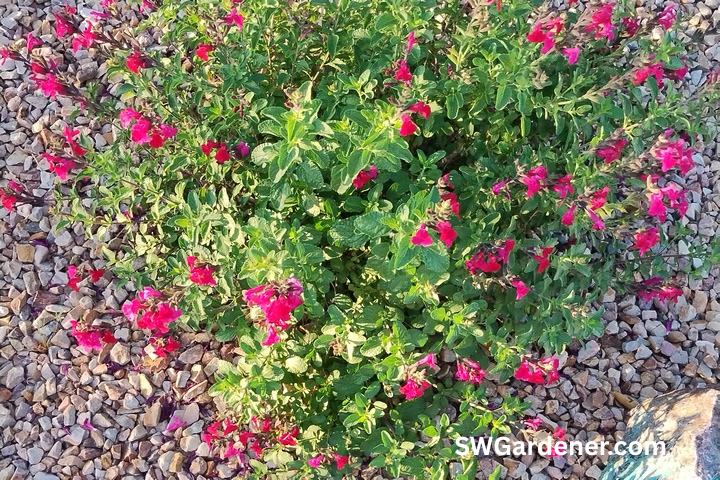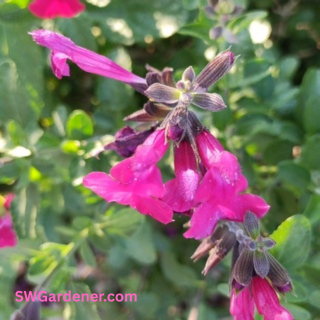Autumn sage is a delightful, compact evergreen shrub with red flowers that bloom most of the year. Here’s everything you need to know about planting and taking care of this Chihuahuan Desert native.

Autumn sage (Salvia greggii) is a small shrub with glossy leaves and dainty flower stalks that would not look out of place in a typical cottage garden. But in fact, it’s a resilient native of the Chihuahuan Desert.
Autumn sage is a low-maintenance plant that keeps its attractive, mounding form with minimal pruning and produces no obvious litter.
Its small but brilliant tubular flowers attract hummingbirds, butterflies, and bees. It is also an important host plant for many native moths.
Unlike many plants with “sage” in their name, autumn sage is a true sage (i.e., member of the Salvia genus). It has a somewhat minty herbal aroma which seems to repel deer, rabbits, and javelinas.
Why I Like This Plant
- Mounding, evergreen shrub
- Flowers come in a rainbow of options
- Low maintenance
- Stays compact, won’t outgrow its space
- Attracts hummingbirds, butterflies, and bees
- No thorns, no litter, non-toxic
Things to Watch Out For
Unfortunately, autumn sage is now becoming borderline heat tolerant. In recent years, they struggle during the summer when planted in full sun or during a heat wave.
This plant comes in cultivars of many colors, but they are not as resilient as the parent plant.

Optimal Growing Conditions
If you’re thinking of adding autumn sage to your garden, you need to find a suitable place that will keep your plant healthy and looking good… while minimizing maintenance for you.
Here are the key factors to keep in mind.
Temperature
Autumn sage should be grown in USDA Hardiness Zones 7 – 11. It is extremely cold-hardy down to around 0°F. However, it suffers from heat stress once the temperature hits 110℉ and should not be planted in the hottest spots in your yard.
Sun Exposure
Autumn sage does best in morning full sun part or part shade. It will struggle with either reflected sun, full shade, or full sun all day. In the summer, afternoon shade is almost a must.
Size and Growth Rate
Autumn sage is considered a moderate-to-faster grower that typically stays around 2 feet tall by 3 feet wide.
Soil
Autumn sage is not particular about soil, provided it’s well-draining. It’s equally happy in sand, loam, or rocky desert soil.
Other Location Considerations
Because it has no thorns, is non-toxic, and litter-free, it’s a plant you can feel comfortable placing near a pool, sidewalk, or anywhere it might come in contact with pets and people.
But don’t plant it where it may get foot traffic. Autumn sage wood is thin and brittle and easily damaged if stepped on by people or animals. However, if your plant does get damaged this way, it rebounds readily.
A few times a year, javelinas stomp through my front yard. And while they don’t eat my autumn sage, they usually break some branches. It’s not a problem, I trim away the damage and new growth fills in promptly.
Autumn Sage:
The Essentials
| Common Name | Autumn sage |
| Scientific Name | Salvia greggii |
| Origin | Chihuahuan Desert |
| Plant Type | Evergreen shrub |
| USDA Zones | Zones 7 – 11 |
| Cold Hardy | To 0℉ |
| Flower Color | Red (see “Cultivars”) |
| Flower Season | Spring, summer, fall |
| Mature Size | 2’ high x 3’ wide |
| Growth Rate | Moderate |
| Sun Tolerance | Full, part sun |
| Water Needs | Low to moderate |
| Pests & Diseases | Spittle bug |
| Garden Friendly | No thorns, no litter, non-toxic |
| Wildlife | Attracts bees, hummingbirds |
How to Plant
The rule of thumb when planting any shrub in the desert is to dig a hole three times as wide as the root ball but no deeper. Amending the soil is not recommended. Counterintuitively, backfilling with the same native soil you just dug up helps your plant develop a stronger root system.
When to Plant
The best time to plant autumn sage is in the fall. This gives your shrub three seasons to grow roots and get established before the following summer.
The second best time is in spring, the earlier the better. This still gives your plant time to get established before the intense heat of June arrives.
How to Care for Autumn Sage
Whether you’ve recently planted an autumn sage or have an existing plant in your yard, here’s how to take care of it to keep it healthy and looking its best.
How to Water New Plants
Once you’ve got your autumn sage in the ground, watering is your most immediate concern. Here is the recommended watering schedule for new shrubs planted in the spring or fall.
| Weeks 1 & 2 | Every 3 – 4 days |
| Weeks 3 & 4 | Every 6 – 7 days |
| Weeks 5 & 6 | Every 7 – 10 days |
| Weeks 7 & 8 | Every 10 – 14 days |
After week 8, gradually extend the time between waterings.
How to Water Established Plants
As your shrub gets established, there are two watering factors to consider.
- First is how often to water. This will vary with the seasons.
- Second is how much water to give your shrub with each watering. This depends on the current size of your plant.
To determine the ideal watering schedule for any desert shrub, you’ll find everything you need to know, including easy-to-use charts, at How to Water Desert Shrubs: How Often? How Much?
Should You Fertilize?
There is no need to fertilize autumn sage. As a desert native, it gets all the nutrients it needs from native soil.
How to Prune
Autumn sage has a naturally attractive mounding form, and since it’s a small plant, it’s very easy to keep it in shape.
You can cut it back by half in August to shape, invigorate, and remove any damaged branches.
You can remove spent flowers any time to encourage more blooms and make your plant look more tidy, but this is optional. New flower stalks appear quickly after trimming.
Autumn sage can get spindly, so every few years you might want to cut it back in late spring to around half its size.
If warranted, you can trim it back to 4″ in late winter, but there’s always a chance it won’t grow back. If that happens, don’t be hard on yourself, since these are relatively short-lived plants anyway.
Pests & Diseases
Autumn sage is generally pest and disease-free. The only insects I’ve seen on my plants are spittlebugs, which appear as small spots of white foam. They won’t harm your plant, so you can let them be. Or you can hose them off or gently wipe them with your finger.
Autumn Sage Cultivars
In its native habitat, autumn sage has red flowers.
Don’t like red? No worries!
There are dozens of colorful cultivars and hybrids to choose from. Besides coming in nearly every shade of red and pink, they come in a wide variety of colors.
One of the most popular autumn sage hybrids is ‘Hot Lips’ (Salvia × jamensis). It’s a hybrid cross between autumn sage and baby sage (Salvia microphylla). It has eye-catching two-tone red and white flowers.

Here’s a sampling of some other cultivars you may come across when plant shopping:
- ‘Alba‘ (white)
- ‘Fuhrman’s Red‘ (magenta)
- ‘Ignition Purple‘ (deep purple)
- ‘Salmon‘ (salmon)
- ‘Sierra de San Antonio‘ (peach)
- ‘Sierra Linda‘ (bubblegum pink)
- ‘Sparkle‘ (purple)
- ‘Raspberry Delight’ (fuschia)
- ‘Wild Thing’ (shocking pink)
Before you buy other colors, be aware that cultivars are often not as resilient as the parent plant.
Plant Lover Facts
Autumn sage has many alternative common names, including cherry sage, Gregg salvia, Gregg’s sage, red Chihuahuan sage, and Texas red sage.
It is native to Texas and northeastern Mexico.
Frankly, the name autumn sage has always puzzled me since it blooms almost all year, not just in autumn. 🤔
Reportedly, parts of autumn sage are edible. The flowers can be eaten, and the leaves can be used to make tea. But I haven’t tried either, so I can’t attest to how tasty they are.
Did you enjoy this article?
Sign up for our weekly newsletter
where you’ll find more great info on creating &
maintaining a beautiful, carefree desert landscape.
Author Bio
Deane Alban is the creator of Southwest Gardener. She is a science writer with a bachelor’s degree in botany from the University of South Florida. Gardening is her lifelong passion. She’s been gardening in Tucson for over 15 years.

